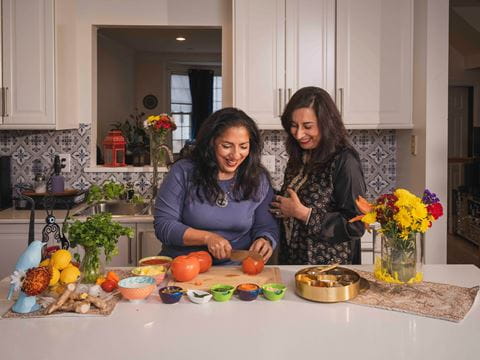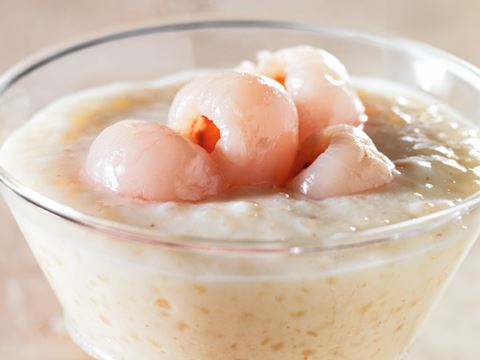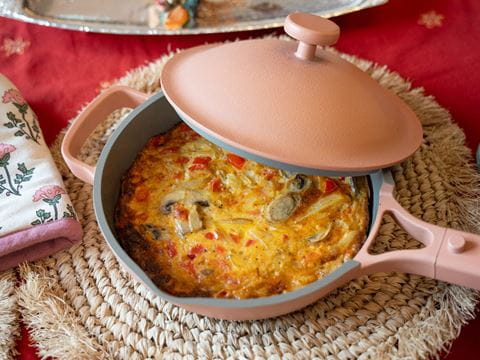
Artichokes to Ricotta: How Arab Rule Changed Sicilian Cuisine
The cultivation methods, crops and dishes that Arabs introduced in Sicily not only survive but thrive today through foods that are integral and widely celebrated.
Salvo Nicolosi points to the side of a dirt road that cuts through kilometers of orange groves and ancient fields of grain in Lorenzo Frasson, a former aristocratic plantation in his hometown of Ramacca, Sicily, which is now one of the largest farms on the island.
Littering the soil are shards of red brick and painted ceramic that likely predate the ninth century CE, he says. Nicolosi, who was once mayor of Ramacca, travels with several paperback books, which he independently wrote about Sicilian history, in the trunk of his car. “This clay tells a story about how this area was once ruled by powerful empires and kingdoms,” says Nicolosi, “that early on included the Romans, Vandals, Ostrogoths and Byzantines.”

Left: Oranges are harvested at the Lorenzo Frasson farm. Arabs introduced irrigation methods that enabled the growth of orange groves in Sicily. Right: Lorenzo Frasson owns the company bearing his name, which has used seeds from Syria and other Arab countries for grains and pastas.
It’s an exhilarating find for the uninitiated, who might see such artifacts only in a museum. However, one’s gaze should focus on the oranges as well because, as some historians maintain, they recall the next chapter in the island’s history that began in 827 CE.
At the time, the commander of Sicily’s maritime fleet, Euphemius, was in revolt against the Byzantine Emperor Michael II, says Luca D’Anna, an associate professor of Arabic dialectology at the University of Naples. To aid in his rebellion, Euphemius called on armies in Ifriqiya, which were located across the Mediterranean Sea in present-day Tunisia. These forces eventually would defeat the Byzantines, and while doing so, sidelined Euphemius to become the first of three Arab dynasties to rule over the island until 1091 CE.
What transpired over these two-and-a-half centuries would result in a complete transformation of the agricultural and culinary landscape. And while direct paths are sometimes difficult to pinpoint, it’s clear that the cultivation techniques, crops and dishes that Arabs introduced in Sicily not only survive but thrive today through foods that are integral and widely celebrated.
The idea of frying is a specific cooking technique imported during the Arab conquest.

Left: Alfio Di Stefano makes arancini at his restaurant in Ficarazzi, near Catania, Sicily. Right: The rice balls are stuffed, coated with breadcrumbs and then deep fried. Arancini are said to have originated in 10th-century-CE Sicily, when the island was under Arab rule.
Arab introductions to agriculture
“The Romans and the Byzantines treated Sicily like a granary,” says D’Anna, “because wheat does not require a lot of water in a climate that can become semiarid during the summer.” He says Sicily’s new rulers had a better understanding of how to overcome these challenges and introduced a network of underground waterways, communal fruit and vegetable gardens in relatively cooler valleys, housing that incorporated heat-resistant architecture and irrigation methods that redirected water through small channels—enabling the growth of orange groves similar to the ones Nicolosi would travel through nearly 1,200 years later.
While pontificating about an Arab prince who was responsible for adding peppercorns to Sicilian sheep’s cheese, Nicolosi stops his car to show off a cardoon thistle. “The milk of this plant was used by the Arabs to make cheese,” he says, “because pig’s rennet, which is often used today to make some cheese, is not consumed by Muslims.”

“Since the old times, this place was focused on the production of artichokes,” farmer Francesco Scuderi says of the fertile area of Ramacca, Sicily.
He then drives up to a nearby artichoke farm and greets a local farmer, Francesco Scuderi. Nicolosi picks up an artichoke and with a pocketknife peels back the fibrous outer layer of the thistle’s stem to reveal a delicious inner core that’s both sweet and tender. “We are in one of the most fertile regions of Italy,” says Scuderi. “Since the old times, this place was focused on the production of artichokes.”
In fact, ethnobiologists have been able to link the DNA from certain varieties of artichoke in Sicily to those grown in North Africa, and linguists note that the Sicilian word for the vegetable, cacocciuli, comes from the Arabic word kharshuf.
However, due to a lack of written records during the Arab conquest and the centuries thereafter, “attempting to trace the direct migratory patterns of these foods through a culinary family tree is nearly impossible,” says Clifford Wright, a James Beard Award-winning author of several books about Italian food history, who also wrote the culinary entries for Columbia University’s Encyclopedia of the Modern Middle East. He warns that in Sicily, asserting something is “Arab is enough to make it cucina arabo-sicula, or Arab Sicilian cuisine,” explaining that Sicilians might understand a particular food is Arab through unverifiable folklore instead of peer-reviewed academic research. Wright also notes that Sicilians argue even today over the basic tenets of their cuisine.

Left: Cheesemakers stir vats of fresh ricotta during the Festa dei Sapori e dei Saperi (Festival of Flavors and Knowledge) in Vizzini. Right: A father and son split one of the cannoli on offer in Palermo. The traditional pastry is stuffed with ricotta, which has its origins in North Africa.
Linguists note that the Sicilian word for artichoke, cacocciuli, comes from the Arabic word kharshuf.
Is this Sicilian street food Arab?
Take one of Sicily’s most famous street foods: arancini. No greater culinary rivalry may exist than between the cities of Catania and Palermo over whether a fried clump of rice and meat should be considered masculine or feminine.
“It’s masculine, for sure,” says Alfio Di Stefano, a 63-year-old master of this street food, who makes them daily in his restaurant Pizzeria Savanas in the small town of Ficarazzi, just outside Catania. For Di Stefano, the conical shape of what he calls arancino is reminiscent of un albero di arancio, or an orange tree. The “o” ending means it’s taken on the masculine form. That’s in stark contrast to Palermo, where instead of cones, the rice is balled up to resemble just the orange, or una arancia, a feminine word because it ends in “a”.
Linguistic arguments aside, to prepare arancini Di Stefano wakes up early in the morning to boil short- grain carnaroli rice. He then mixes in saffron, butter and shredded edam, a semihard cheese from the Netherlands. Shaping handfuls of the sticky concoction into cones, Di Stefano stuffs the rice with a ragù, or meat sauce. The ground beef has been stewed in a tomato-based sauce for a couple of hours with olive oil, carrots, celery and onions, along with some green peas for good measure. The naked arancini are then dipped in a batter of flour and water, rolled in breadcrumbs and deep-fried.

The Festa dei Sapori e dei Saperi in Vizzini celebrates all things ricotta.
In a single weekend, Di Stefano will make up to 500 arancini for his restaurant’s tavola caldo, or hot table, where diners feast on a selection of warm and cold appetizers. Every September up to 20,000 of these fried cones will be served over Ficarazzi’s four-day Sagra di Arancini, a festival Di Stefano helped to start a quarter century ago.
“So what’s the relationship to the Arabs here?” Wright rhetorically asks. “Well, there’s two,” he says. “One is the use of rice because it’s thought that rice was brought to Sicily by the Arabs, and [the second] is in the 13th-century Arab cookbook that’s known as the Kitab al-Tabikh, or Book of Dishes.” Wright says the work by the Baghdadi writer Muhammad bin Hasan al-Baghdadi includes “a recipe called nāranjīya, and although it’s not made with rice, it’s a ball of meat fried to look like an orange, using saffron and eggs to affect the color.” He notes that the word arancini is a derivation of the word narenj, which in Arabic means “bitter orange.”
For Wright this does not guarantee that Sicily’s Arab rulers invented the arancini served by Di Stefano, pointing out that the ragù in the dish is likely a cousin of the ragout made in France, a country that briefly ruled the island in the 13th century. But he says it does indicate that 264 years of Arab rule left an indelible mark on Sicilian cuisine.

Cannoli are a popular pastry and widely sold in Palermo.
Preservation of Sicilian foods
And yet there is another clue pointing to the Arab influence on arancini. “The idea of frying is a specific cooking technique imported during the Arab conquest,” says Gabriele Proglio, an associate professor of contemporary history at the University of Gastronomic Sciences of Pollenzo. Proglio’s department includes a team of ethnobiologists, sociologists and anthropologists who study, in part, the migratory patterns of food. He says frying was a method employed by Arabs, in part, to preserve food, especially for an imperial power that needed to feed its soldiers over long distances.
Another of those preservation techniques, says Proglio, can be seen an hour’s drive from Di Stefano’s restaurant in the town of Vizzini, which around April celebrates the Festa dei Sapori e dei Saperi, or the Festival of Flavors and Knowledge.
Parades of accordion-playing folk musicians, riding in colorful horse-drawn carriages, pass by 59-year-old farmer Vito Barbuzza, who stirs a barrel of milk that sits atop a gas burner. “First, I’ll add sheep rennet to the warm milk,” says Barbuzza, “which after some time will split it into curds on the top and whey on the bottom.”

Left: The town of Ramacca rises among the hills and valleys of east-central Sicily. Artichokes, grown and celebrated in the fertile area of Italy, share DNA with those grown in North Africa. They are among Sicilian foods of Arab origin. Right: A cheesemonger sells ricotta and other cheeses during the Festa dei Sapori e dei Saperi.
He skims off the curd and strains it for a few hours, turning it into a soft cheese called tuma. During that time he reheats the whey, stiffening its remaining proteins, which creates ricotta (meaning recooked), an iconic ingredient that is exhibited in countless savory and sweet dishes at the festival, including cassata cake decorated with almonds and candied fruits, a variety of cannoli, and orange and lemon cassatelle—all of which boast influences in both recipe and technique from Sicily’s Arab history.
Long lines of local residents eagerly wait to be served by Barbuzza, who makes hundreds of kilos of ricotta during the festival. Lucio Nasca greedily slurps down a bowl, letting it dribble down his chin and chest. “Vizzini has been making this ricotta for centuries,” he says with a gregarious, ricotta-covered smile. “Ever since I was a little boy, I have to admit, I can’t resist eating it in this way.”
While ricotta is technically not a cheese, says Proglio, it’s produced with a method of making acid-coagulated cheeses, which was popularized in Sicily by the Imazighen, or Berber, people of North Africa. He says it’s akin to Jben, a soft cheese found in Morocco. However, Proglio notes that the “ricotta” made in ninth-century Ifriqiya would have tasted more acidic, explaining that as people migrate, the flavor profile of their food tends to mellow to better integrate with established communities, in the same way that Indian or Mexican cuisine tends to be less spicy in the United States.
Proglio also points out that migration is just as important as colonialization when measuring the influence Arabs have had on Sicilian cuisine. “We cannot limit the spread of Arab food to the conquest of Sicily between the ninth and eleventh centuries,” says Proglio, adding, “there are records that show how couscous—a historical and modern staple of Sicilian cooking—appeared much earlier.”
He says it showcases the long-lasting ties between Sicily and North Africa that fostered a relationship—one that survives in, among many other things, the oranges, artichokes, ricotta and rice that are fundamental in today’s Sicilian kitchens.
About the Author

Jack Zahora
Jack Zahora is an award-winning journalist whose work has appeared on various major outlets including National Public Radio and Al Jazeera English. He’s also the Chief Content Officer and managing partner of TW Storytelling Agency, a media company that’s based in Lisbon, Portugal.
Tara Todras-Whitehill
Tara Todras-Whitehill is an award-winning photojournalist and CEO of the TW Storytelling Agency, based in Lisbon, Portugal. Her passion is empowering NGOs, social impact teams, and journalists with impactful storytelling.
You may also be interested in...

How a Quest To Perfect Butter Chicken Rekindled Memories and Heritage
Food
What begins as a lesson in a beloved recipe becomes a journey through diaspora, friendship and the scents that tie us to places we’ve never lived.
Muhalbiyat Al-Sagoo: A Fresh Spin on Sago and Lychee Pudding
Food
Obtained from the trunks of various palms, sago is used across Asia as a thickener for soups and stews and to make pudding. You can substitute other soft, sweet fruit like plums or pineapple, but the sweet juice of the lychee blends very well with milk. This is an exotic take on the traditional sago pudding popular in Gulf cuisine, made with sago, sugar and spices.
Recipe: How a Spanish Tortilla Got Me Over My Distaste for Eggs
Food
A lifelong egg aversion softens through a recipe by Jeff Koehler for a simple Spanish tortilla and the quiet resourcefulness it shares with Pakistani kitchens.